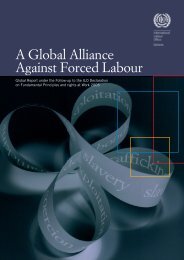equal by law, unequal by caste - International Dalit Solidarity Network
equal by law, unequal by caste - International Dalit Solidarity Network
equal by law, unequal by caste - International Dalit Solidarity Network
You also want an ePaper? Increase the reach of your titles
YUMPU automatically turns print PDFs into web optimized ePapers that Google loves.
340 Wisconsin <strong>International</strong> Law JournalVI. CONCLUSIONThe <strong>law</strong> as a mechanism for achieving social change has fallendrastically short of delivering on its paper promise of ensuring <strong>equal</strong>ity.While legally sanctioned forms of <strong>caste</strong>-based discrimination have beenlargely abolished, discrimination and in<strong>equal</strong>ity persists, adapts, andeven thrives in environments seemingly hostile to its growth—environments that out<strong>law</strong> de jure discrimination and seek to ensure nondiscriminationand substantive <strong>equal</strong>ity through the availability ofconstitutional remedies, protective legislation, and social welfareprograms.As with other countries with a history of institutionalized orlegalized racism or <strong>caste</strong>ism, the dismantling of de jure discriminationcomplicates the project of making visible ongoing and structural forms ofdiscrimination. India’s remarkable affirmation of <strong>Dalit</strong> rights throughconstitutional privileges and legislative protections is a double-edgedsword. On the one hand, it lays the foundation for real socialtransformation. On the other hand, it masks the daily reality of de factosegregation, exploitation, and other forms of abuse <strong>by</strong> discouragingfurther scrutiny into the condition of <strong>Dalit</strong>s.The role of discourse in shaping and informing affirmativeaction policies and debates is in need of further examination. Despite thevirulence of racism and in<strong>equal</strong>ity in the world today, the categorizationof affirmative action as a program to address “historic” forms ofdiscrimination is accepted, seldom debated, and now increasinglycircumscribed. This Article offered a different scale of interrogation andforegrounds these debates in empirical realities and puts them inconversation with the struggle to achieve racial justice in the UnitedStates. A variety of formal mechanisms ranging from protectivelegislation to affirmative action policies have not penetrated the <strong>caste</strong>ceilingin any real sense, and the market has not proved to be an<strong>equal</strong>izing mechanism. Despite a large body of legislation andadministrative agency mandates assigned exclusively to deal with theoppression of scheduled <strong>caste</strong>s, the <strong>law</strong>s have benefited few anddevelopment programs and welfare projects designed to improveeconomic conditions for <strong>Dalit</strong>s have generally had little effect.In order to effectively redress entrenched discrimination against<strong>Dalit</strong>s and ensure their substantive <strong>equal</strong>ity, the testing of these formal
















